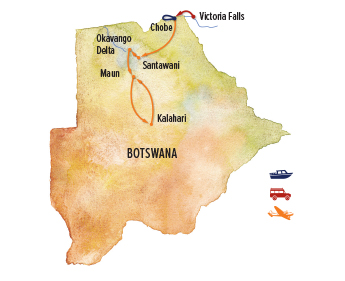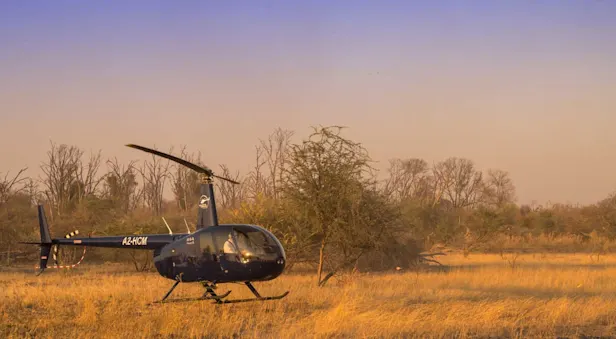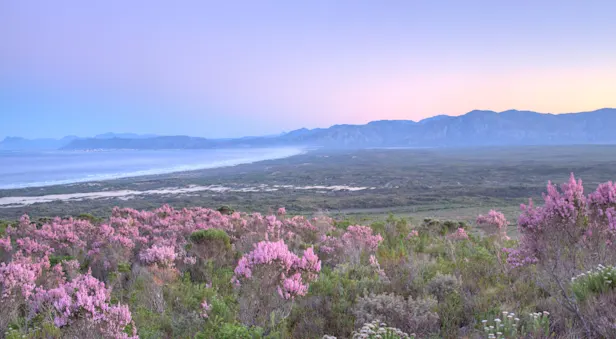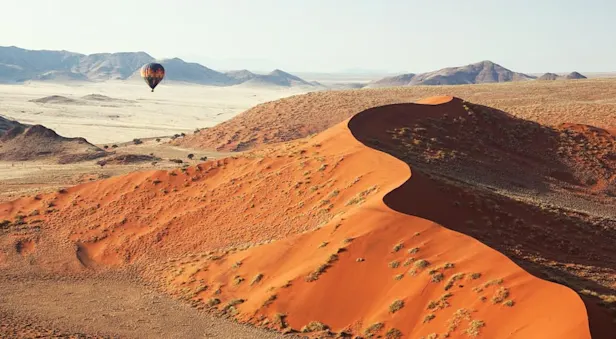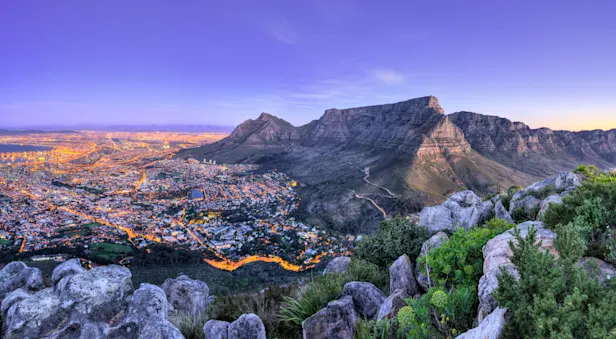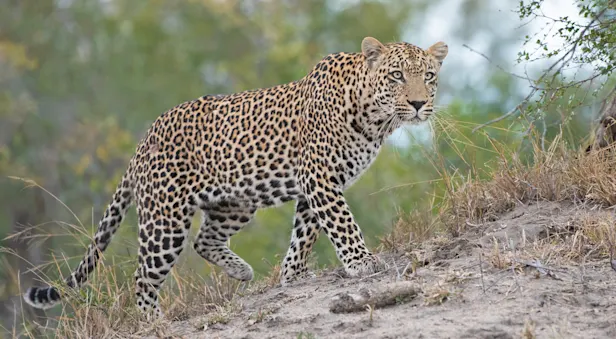Itinerary
Our Botswana green season safari begins just over the border in Livingstone, Zambia, where our Expedition Leader meets you on arrival at the airport. Transfer to Toka Leya Camp on the banks of the mighty Zambezi. Individual chalets face west over the river for sunset views, and we frequently see and hear elephants and hippos on shore. Admire the scenery on a sunset cruise before returning to camp for a welcome dinner.
Our focus today is Mosi-oa-Tunya National Park, which means "the smoke that thunders" in the local Kololo and Lozi languages—a reference to the park's centerpiece, Victoria Falls, which we explore on a guided walking tour this morning. The world's most astounding cataract, Victoria Falls spans more than a mile and plummets 350 feet into the Zambezi Gorge below, producing so much spray that the intense moisture has created a rain forest microecosystem on the rim. A network of walkways offers varying viewpoints over the falls, with exciting photography opportunities.
Next, we visit a nearby village to learn about the culture and daily life of the local people. Then, we head farther into the national park to look for white rhinos—our best chance to see them up close. This small but growing population currently numbers 10 individuals including calves. They’re carefully managed and protected from poaching by around-the-clock armed guards. Because predators do not live in the park, we approach the rhinos via a short walk through the diverse landscape, a combination of tall riverine forests, woodland and open grasslands. We’re likely to see elephants, giraffes, baboons, plentiful birds and zebra. But the true prize is encountering the placid rhinos, endangered icons of the African wild. During the excursion, we follow the rhinos' movements and observe their behavior as we learn about the critical conservation measures striving to bring this population — and the entire species — back from the brink.
Leaving Zambia by road, we reach the Kazungula border on the Chobe River, where Botswana, Zambia, Zimbabwe and Namibia meet. Entering Botswana, our destination is Chobe National Park, known for its enormous elephant herds and stable population of general wildlife species throughout the year. On a private boat cruise on the Chobe River, expect to see elephant, hippo, crocodile and possibly the more elusive puku and Chobe bushbuck. Up to 400 bird species reside in the park at this time of year, and waterbirds abound, especially herons, storks and egrets. Later this afternoon we fly by light aircraft to Nat Hab's Gomoti Camp in the heart of the community-owned Santawani Concession in the Okavango Delta. This small, intimate camp is reserved exclusively for our group, offering a tremendous sense of seclusion on this private reserve.

Earth's largest inland water system, the Okavango Delta, became UNESCO's 1,000th World Heritage Site in 2014. The Okavango River’s headwaters lie in the western highlands of Angola, joining with other rivers in Namibia and Botswana to meet the Kalahari Desert, where a green oasis sprawls amid the sands and dry savanna. With its vast network of channels and wetlands, the delta is home to a profuse collection of wildlife and vegetation. Though some of the region is permanently flooded (or typically has been in years past), the water recedes during the southern summer months, opening up normally wetter areas of the delta for game drives and expansive wildlife viewing. Specific wildlife sightings, while always abundant, will depend somewhat on seasonal water levels.
Beyond the flooded areas, a mosaic of varied landscapes includes drier zones like the one surrounding our private Gomoti Camp. A mix of riverine woodland, acacia scrub and open floodplains provides ample food for a large array of browsers and grazers as well as predators. During a private visit with an on-site predator researcher, learn about local studies on wild dog, cheetah and leopard. Wildlife is abundant around camp, and we often see animals wandering through. The diverse range of habitats, plus the year-round lifeline of the Gomoti River, make this region ideal for all-day wildlife excursions, including on traditional 4x4 game drives and night drives. Regular sightings include leopard, lion, wild dog, hyena, cheetah, giraffe, elephant, impala, kudu, zebra, wildebeest and buffalo. Birdlife is also outstanding, and we may see ground hornbill, crimson-breasted shrike and yellow morph, among many others. In the evenings, paraffin hurricane lanterns and a crackling campfire create a romantic ambience in camp.
This afternoon we fly to the center of the Okavango Delta for a three-night stay on the private Jao Concession, marked by palm-studded islands, riverine forests and sprawling floodplains. Our secluded camp is set within a productive wetland nurturing water-adapted wildlife like the rare sitatunga and abundant red lechwe. In the summer months when typical inundation recedes, lechwe, tsessebe and elephant are prevalent, and we may see lion and the occasional leopard. In the channels, look for hippos and crocodiles, plus scores of birds in the marshes. Pel's fishing owl is a prize sighting, and we may spot African and lesser jacanas, slaty egret, African skimmer, wattled crane and malachite kingfisher, to name just a few. Wildlife concentrations depend on water flow and volume, changing from season to season.
Encounter wildlife in thrilling proximity on 4x4 drives, guided walks (safety permitting), and poled mokoro excursions if water levels permit. The mokoro is the traditional dugout canoe of the delta, and Okavango-born polers reveal intimate secrets of delta life as we spot tiny frogs and colorful waterbirds. Guests may also add an optional 30-minute helicopter flight over the greater Okavango Delta (additional cost), with doors off for the most spectacular photography opportunities! Each evening, retreat to camp for dinner and stories around the flickering campfire before retiring under canvas, surrounded by the night sounds of the African bush.
Please note: Water levels and activities may vary based on actual amounts of annual rainfall.
Transfer via Maun by light aircraft to the eastern side of the 360,000-square-mile Kalahari Desert, enjoying a thrilling aerial view on the stark landscape and roaming wildlife below. Our tented camp rests on the edge of the world’s largest salt pan, an oasis of comfort shaded by acacia and palm trees. The Makgadikgadi Pans formed when an ancient lake evaporated thousands of years ago, and these shallow depressions are all that remain of once-enormous Lake Makgadikgadi. Today, this vast expanse of salt glitters in the intense sun, evoking a moonscape. The only visible plant life is a thin layer of blue-green algae, but seasonal rains turn the pans into an important habitat for migrating animals, including wildebeest and one of Africa's largest zebra populations, along with the predators that pursue them, including the Kalahari's famous black-maned lions.
During our visit, look for unusual desert-adapted creatures on private game drives as we head out in search of gemsbok, springbok, red hartebeest and steenbok, plus many small mammals such as honey badger and mongoose, and plentiful birds and reptiles. We'll also interact with a friendly habituated colony of meerkats. The Kalahari is the ancient home of the San people, who have subsisted in these austere environs for millennia. Our time includes cultural engagements offering insight into the history and traditions of the clans in the area. Back at camp each night, enjoy some of the best stargazing on the planet.
Our Botswana safari comes to a close today when we depart by air for Maun to connect with onward flights.
Click here to view the seasonal variations of weather and wildlife viewing in Botswana.



















